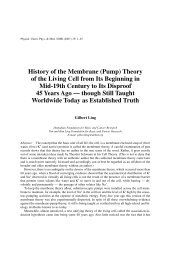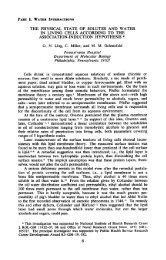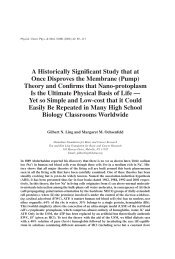Primary Thermosensory Events in Cells - Springer
Primary Thermosensory Events in Cells - Springer
Primary Thermosensory Events in Cells - Springer
You also want an ePaper? Increase the reach of your titles
YUMPU automatically turns print PDFs into web optimized ePapers that Google loves.
25 <strong>Primary</strong> <strong>Thermosensory</strong> <strong>Events</strong> <strong>in</strong> <strong>Cells</strong> 461<br />
B. Nilius and co-workers have recently applied this simple thermodynamic<br />
formalism to describe the shifts <strong>in</strong> voltage dependence of prote<strong>in</strong> channels due<br />
to changes <strong>in</strong> temperature [70, 71], where the probability of the open<strong>in</strong>g of a<br />
channel is def<strong>in</strong>ed as a function of temperature, Faraday’s constant, the gat<strong>in</strong>g<br />
charge, and the free energy difference between open and closed states of the<br />
channel.<br />
In order to understand the nature of dynamic transitions <strong>in</strong> prote<strong>in</strong>s, it is also<br />
important to consider solvent effects. Solvent can affect prote<strong>in</strong> dynamics by<br />
modify<strong>in</strong>g the effective characteristics of the prote<strong>in</strong> surface and/or by frictional<br />
damp<strong>in</strong>g. Changes <strong>in</strong> the structure and <strong>in</strong>ternal dynamics of prote<strong>in</strong>s <strong>in</strong> dependency<br />
on solvent conditions at physiological temperatures have been found by us<strong>in</strong>g<br />
several experimental techniques [72–74]. It follows from the works of G. Büldt,<br />
G. Artmann, J. Zaccai, A. Stadler and others that solvent affects prote<strong>in</strong> dynamics<br />
differently at different temperatures and salt concentrations [74–77] Therefore,<br />
a solvent dependence of the dynamic transition might be expected. Indeed, measurements<br />
on ligand b<strong>in</strong>d<strong>in</strong>g to myoglob<strong>in</strong> <strong>in</strong>dicated that dynamic behavior of the<br />
prote<strong>in</strong> is correlated with a glass transition <strong>in</strong> the surround<strong>in</strong>g solvent [78]. Recent<br />
molecular dynamics analysis of hydrated myoglob<strong>in</strong> also <strong>in</strong>dicates a major solvent<br />
role <strong>in</strong> prote<strong>in</strong> dynamic transition behavior [79].<br />
One <strong>in</strong>terest<strong>in</strong>g aspect of thermosensation is conversion of the code conformational<br />
changes <strong>in</strong>to the code of cellular signal<strong>in</strong>g. In our op<strong>in</strong>ion, strong<br />
methodological basis for the understand<strong>in</strong>g of these events was provided by studies<br />
by the scientific schools of Dmitrii Nasonov and Gilbert L<strong>in</strong>g that have ga<strong>in</strong>ed new<br />
appreciation over the last 20–30 years ow<strong>in</strong>g to advances <strong>in</strong> prote<strong>in</strong> physics, and<br />
thank to series of works by Vladimir Matveev [80, 81]. The latter has postulated<br />
that when an action (for <strong>in</strong>stance, temperature change) on a cell or a cell structure<br />
exceeds the threshold, (i) formation of secondary structures beg<strong>in</strong>s <strong>in</strong> natively<br />
unfolded prote<strong>in</strong>s (or unfolded regions of prote<strong>in</strong>s), while (ii) secondary structures<br />
of molten globules start to become accessible for <strong>in</strong>teraction with secondary structures<br />
of other prote<strong>in</strong>s and with nucleic acids. Such secondary structures <strong>in</strong>duced<br />
by the external action were called by the author centers (sites) of native aggregation<br />
(personal communication). Thus, the first event <strong>in</strong> the activated cell is the<br />
appearance of new secondary structures able to <strong>in</strong>teract selectively with each other<br />
to form tertiary, quaternary, etc. structures. Prote<strong>in</strong>s whose secondary structures<br />
appear under such circumstances lose their previous <strong>in</strong>ertia and become reactioncapable.<br />
This po<strong>in</strong>t of view on understand<strong>in</strong>g the mechanisms of cellular reactions poses<br />
the question of native and denatured prote<strong>in</strong> states <strong>in</strong> a new way. Accord<strong>in</strong>g to it,<br />
<strong>in</strong> the native state the key cell prote<strong>in</strong>s are <strong>in</strong>ert, non-reaction-capable; they do<br />
not <strong>in</strong>teract with each other or with other biopolymers. Loss of the state of <strong>in</strong>ertia<br />
is partial denaturation, where new secondary structures can appear, or can be<br />
modified, or can “float up” to the surface from the hydrophobic nucleus. In all<br />
cases the secondary structures are ready to <strong>in</strong>teract. Numerous <strong>in</strong>termediate prote<strong>in</strong><br />
species, correspond<strong>in</strong>g to different free energy m<strong>in</strong>ima provide basis for native<br />
aggregation.







